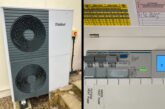
Hager’s Technical Training Manager, Paul Chaffers, discusses the importance of providing additional fire protection, following the mandated use of Arc Fault Detection Devices (AFDD) in the latest Edition to the Wiring Regulations BS 7671:2018+A2:2022.
Way back in 2008 the 17th Edition of the Wiring Regulations was released and contained a new section “532 Devices for the protection against the risk of fire”.
Within that section, there was a mention of devices intended to provide protection from arc faults, but it was buried away in a “note” containing informative guidance. Fast forward ten years to the 18th Edition 2018, where AFDDs became “recommended” and it is here that most designers started to really take notice.
Recommendations
The issue with any recommendations provided in the Wiring Regulations is knowing when to follow them. Some say they’re only informative and therefore can be ignored. However, BS 7671 lists guidance on the language used within the Wiring Regulations and defines a recommendation as:
“Expression in the content of a document conveying that among several possibilities one is recommended as particularly suitable, without mentioning or excluding others.”
Furthermore, it states that the implication of a recommendation means you should do it.
So, you can see why designers struggle with omitting safety devices when they’re recommended.
Mandatory requirement
BS 7671:2018+A2:2022 saw the mandating of AFDDs for the first time for a select amount of installation types. The Regulation addresses buildings with a higher risk, concerning the level of difficulty for evacuation in an emergency, and considers the habits and capability of users.
Regulation 421.1.7 requires AFDDs to conform to BS EN 62606 and be used on single-phase circuits supplying socket-outlets with a rated current not exceeding 32 A in:
● Higher Risk Residential Buildings (HRRB),
● Houses in Multiple Occupation (HMO),
● Purpose-built student accommodation,
● Care homes.
For all other premises, AFDDs are recommended for single-phase circuits supplying socket-outlets with a rated current not exceeding 32 A.
Installation requirements
Regulation 532.6 requires that where AFDDs are specified they shall be installed at the origin of the circuit. This means installations with more than one socket-outlet circuit will require one AFDD per a circuit, as illustrated in Fig 1.

It’s clear that AFDDs will be required for any work that involves the installation of new socket-outlets in one of the listed installation types, including:
● New builds,
● Rewires,
● Additions and alterations to socket-outlet circuits.
It should also be noted that AFDDs will need to be specified for any of the four installation types requiring a consumer unit replacement. Such additions and alterations are classified as new work and therefore must be designed, erected and verified in accordance with the latest version of BS 7671.
Where socket-outlets need replacement for maintenance purposes and the client doesn’t wish to upgrade their circuit protection to include AFDDs, faulty or damaged accessories may be replaced without the addition of an AFDD. This is permitted for safety reasons and is deemed acceptable because adding additional cost to maintenance may prevent it from being carried out. This only concerns a like-for-like swap of damaged accessories and no other alterations.
Increased protection
UK fire statistics report that electrical fires are still unacceptably high. Traditional protective devices that deal with overcurrent, residual current and overvoltage protection reduce the risk and consequence of electrical fire, but none of these can identify an arc fault. See Fig 2 to understand more about levels of protection.

AFDDs use microprocessor technology to analyse the waveform of the electricity being used to detect any unusual signatures which would signify a dangerous arc on the circuit. Numerous parameters are analysed – including the signature, duration and irregularity of the arc – enabling an algorithm to identify arc faults and to differentiate these from normally occurring arcs.
This is essential because every day switching activities produce arcs. For example, from switched and contractors, as well as arcs from equipment with motors, such as portable electrical tools, vacuum cleaners and washing machines. From this, we can see that AFDDs are intelligent devices capable of avoiding unwanted operation.
Inspection and testing
Electricians encountering AFDDs for the first time will need to understand the inspection and testing requirements for both initial verification and periodic inspection.
Fortunately, there are no additional tests to be conducted other than general compliance required by BS 7671. The product standard BS EN 62606 requires AFDDs to have manual or automatic test functions (or both).
The auto test function shall be performed at switch-on and at least every 24 hours. Should a malfunction be detected the device shall trip and indicate failure. The self-test rate will differ between manufacturers, for example Hager AFDDs self-test once every hour.
Functional testing
1. On the first installation of the device, push the test button.
2. Once the test button has been pushed, the device should trip.
Because AFDDs are available as standalone devices or AFDDs that incorporate integrated protective devices, particular care to follow manufacturer’s instructions is needed. There are no requirements for test buttons and fault indicators to be standardised.
Hager’s RCBO/AFDD combined devices have a blue test button which doubles up as the RCD test button. Regulation 514.12.2 requires this to be operated every six months.
Insulation Resistance (IR) testing
Internal components contain sensitive electronics which are connected to the load side of the device. Therefore, caution is needed before applying the 500 V DC IR test, shown in Fig 3.

For initial verification, Regulation 643.3.3 requires a 500 V DC test to be applied prior to the connection of any sensitive equipment that is likely to influence the result of the test or be damaged. Following connection of such equipment a further test at 250 V DC shall be applied.
There is a “Note” that accompanies the Regulation advising the need to check individual manufacturer’s instructions.
For circuits protected by Hager AFDDs they may remain connected to the AFDD during 500 V DC IR testing, providing the following is observed:
● AFDD switch must be in the OFF position,
● AFDD test button must not be pressed.
Earth Fault Loop Impedance (Zs) testing
If an earth fault loop impedance (Zs) measurement is carried out on a circuit containing an AFDD, it is recommended the low current (non-trip) setting is selected on the test equipment. Carrying out this test using the high current method will most likely trip the device, especially for RCBO/AFDD combined devices (see Fig 4).

Learn more about Hager’s range of AFDDs with Pro Tools here








